Commissioned c1816
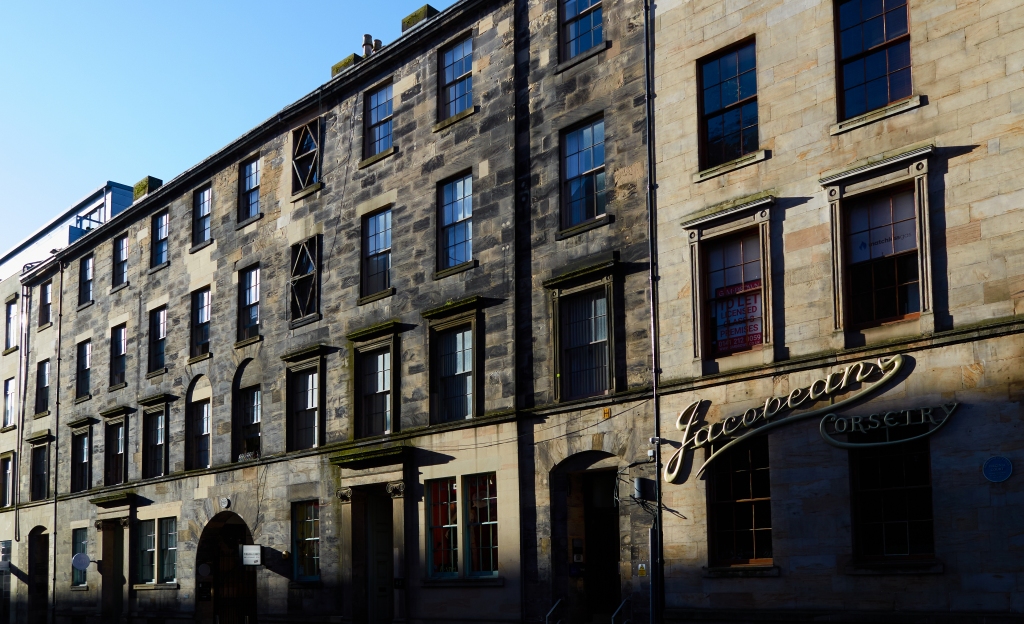
Commissioned by Robert Findlay jnr of Easterhill (1784-1862) for Findlay, Duff & Co. c1816.
From feu & map records there were at least three plots involved.
The centre 8 bays of the Virginia Buildings take up the entire plot that was detailed as ‘875 square yards of ground’ in the original feu of 1754 from George Buchanan of Drumpelier (2nd son of Andrew Buchanan of Mount Vernon) to John Bowman of Ashgrove (1701-1797). Bowman like his father before him was made Lord Provost in 1764-65. He was a merchant don of the elite class. A partner in Speirs, Bowman & Co. among other concerns.
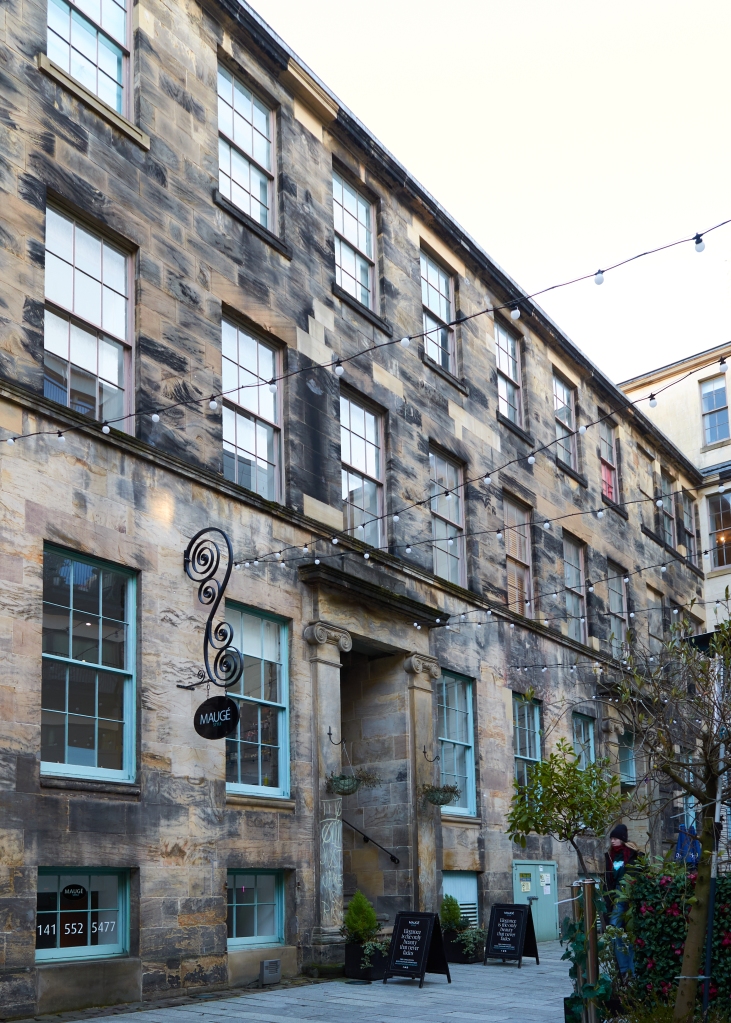
Plot(s)
Built primarily on the original 875 square yard plot of Glasgow Lord Provost John Bowman of Ashgrove. The centre 8 bays match stylistically the interior courtyard. The wings, possibly a later addition, appear to reference the Jacobean Corsetry to the north with the incised detail on the first floor windows. Indeed Fleming’s map of 1807 confirms the Jacobean Corsetry was already in situ prior to the Virginia Buildings.
No37 and No49 Virginia Street form wings to complete the ten bays of the Virginia Buildings. They utilise both the southern gateway of Alexander Speirs’ of Elderslie (c1714-1782) plot to the north and what would appear to be the corresponding north most gateway of John Coats Campbell of Clathick (1721-1804) plot to the south. Coates-Campbell was a founder partner of the Thistle Bank, (Maxwell, Ritchie & Co.) located across the street at No9 Virginia Street. Like Bowman he was made a Lord Provost of Glasgow in 1788.
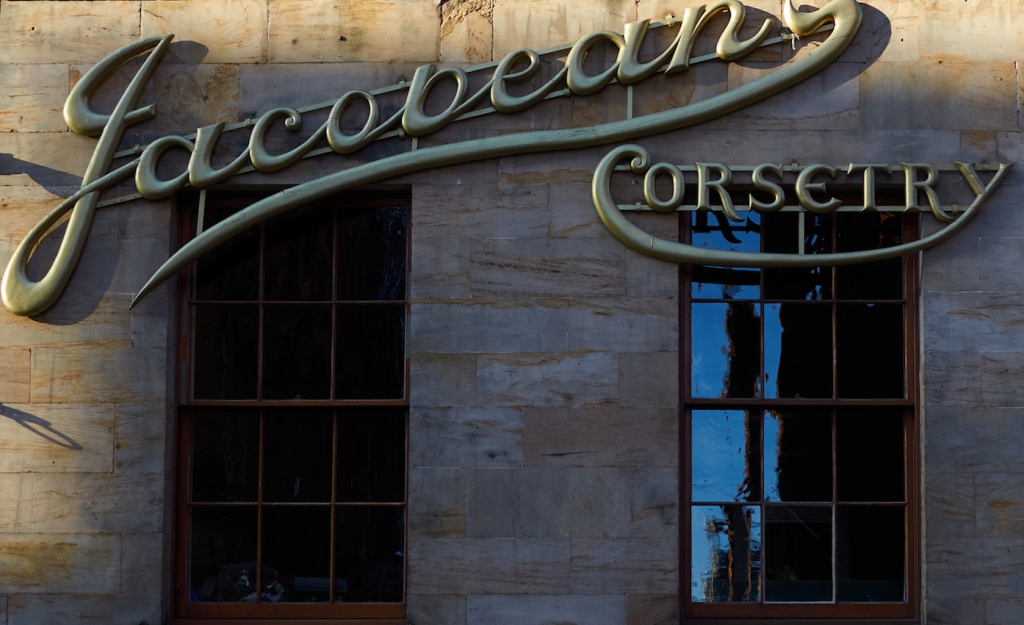
Contrary to popular belief whilst the Jacobean Corsetry was assimilated into the Virginia Buildings on their later purchase by Findlay, Duff & Co. it did not form part of the build commissioned by Robert Findlay jnr. However, there is reason to assume that on acquiring this property the height was raised to match the elevation of the Virginia Buildings to the south.
Later feu records of 1800 & 1836 make the distinction between the Virginia Buildings at 875 square yards and a property to the north (the Jacobean Corsetry).
It is only much later that this distinction is lost and the incorrect assumption made that the Jacobean Corsetry was built after the Virginia Buildings based solely, I believe, on the later purchases by Robert Findlay of Findlay, Duff & Co. (in 1808 & 1816) that were transposed by Senex. The architecture would show that there are stylistic differences between the two. A cursory look at the map evidence would reflect a footprint ten years in advance of the assumed timeline.
A Glasgow Goad Insurance Map of 1889-1946 clearly shows the stairwell of 49 Virginia Street giving access both north and south acting as a ‘bridge’ between the older Jacobean Corsetry at No53 and the new Virginia Buildings. Whereas today the same stairwell only services access north into the Jacobean Corsetry. This probably explains why HES/Canmore lump 49 & 53 Virginia Street together when the correct pairing should be 37-49 & 53 Virginia Street in terms of build timeline and architect(s).
Architect
In an old text I’d read that a ‘Robert Scott’ was responsible for building extensively in Virginia Street. However, with no specific buildings named or in what capacity eg Developer/Builder/Mason/Architect there was little to go on. Indeed, the Thistle Bank that lay opposite had as one of its partners Robert Scot, merchant.
In the local Tait Directory a Robert Scott(1770-1839), architect, was listed who ran a Drawing Academy nearby. This was located at various locations on Argyle Street and Candleriggs. Again, with nothing to tie this Robert to Virginia Buildings I could only ‘park’ the info.
- 1807: 109 Candleriggs ‘Architectural Academy’
- 1808: –
- 1809: 626 Argyle Street ‘Architec. Academy’ 1810/1811/1812/
- 1813: 101 Candleriggs ‘Arcitec. Academy’ 1814/
- 1815: 2 Argyle Street ‘Architectural Academy’ 1816/1817/1818/1819
- 1820: 4 South Hanover St ‘Architect. Academy’*
- 1821: 6 South Hanover St ‘Architect. Academy’* 1822/1823/1824/
- 1825: 25 South Hanover St ‘Architectural Academy’
- 1826: 6** South Hanover St ‘Architectural Academy’*
- 1827: 25 South Hanover St ‘Architectural Academy’
- 1828 –
- 1829: 25 South Hanover St ‘Architect’
- 1830: 118 Argyle St ‘Scott & Wilson’ architects, surveyors etc 1831/1832
- 1833: 23 South Hanover St. ‘Scott & Wilson’ architects, surveyors etc
- 1834: 23 South Hanover St. ‘Scott, Stephen & Gale’ architects, surveyors, later from 1838 civil engineers. 1835/1836/1837/1838/1839/1840/1841.
- 1836: Robert Scott of ‘Scott, Stephen & Gale’ house 72 Norfolk St. 1837/
*Possibly same address. Street renumbering changed 1826. More research required.
** Possible misprint should read ’25’.
(According to Colvin, the Academy was situated in George Street and he ran it in conjunction with a James Watt.)
Recently I was reviewing some documents of 1822 relating to the lease of the Virginia Buildings for Findlay, Connal & Co. the later name for Findlay, Duff & Co. and sure enough the architect was listed as ‘Robt. Scott’. I believe it is Robert Scott (1770-1839) of the Drawing Academy mentioned earlier.
Reading the ScottishArchitects website they list Robert Scott’s known work. What lends weight that he is responsible for the Virginia Buildings is his commission to build St Mary’s in Renfield Street 1824. This was an Episcopalian Church.
Examining the early feuers of Virginia Street was like looking at a congregation of Episcopalians. Indeed, Alexander Oswald and David Dayell were on the management committee for Scotland’s first Episcopalian Church St Andrew’s on the Green. A committee that Alexander Speirs would later join. These ‘Virginia Dons’ were not just joined by business and family they were joined by belief too… and liked a wee sing song judging by the St Andrew’s alternative name the ‘Whistling Kirk’.
The first meeting of the original subscribers and contributors, called by advertisement in the Glasgow Journal was held on the 15th of March, 1750, in the house of Robert Tennent, vintner and the names of the first directors are as follows, viz. : Alexander Oswald, merchant ; Casper Claussen, sugar baker ; James Dennistoune, merchant ; Robert Parr, dyer David Dalyell, merchant; David Cochran, merchant; George Sangster, tobacconist ; Robert Tennent, vintner ; and Andrew Stalker, bookseller. William Paul and Andrew Hunter masons and Thomas Thomson, wright.
” Excerpts from the Sederunt Book Glasgow, 15th May, 1751. Which day it was reported to this meeting that Messrs. Richard Oswald & Company merchants in London (who had been solicited to procure supply for the chapel in London) had, by a letter of the 4th current directed to Messrs. Oswald of Glasgow, informed that in order to obtain a “Brief” in favour of the chapel, it would be necessary to employ a solicitor ; and that in answer to this, Mr. Alexander Oswald, in name of the managers, to the said Richard Oswald & Co., of London, being laid before this meeting, whereby they are empowered to employ a solicitor for the above purpose, on the expense of the managers, in case it was found proper. The managers now present unanimously approve of the said answer in their name, and agree to pay the expense debursed in prosecuting the same.—James Dennistoune ; John Buchanan, jun.’
“‘Glasgow, 26th September, 1751. Which day, in consequence of an advertisement in the Glasgow Journal for a general meeting, this time and place, of all concerned in the English chapel, sundry of them being now met accordingly in the house of John Burns, vintner in Glasgow, and David Dalyell, merchant in Glasgow, was elected preses of the meeting, in the absence of Mr. Alex. Oswald ; and it is agreed, that Dr. John Brisbane, physician in Glasgow, and Alex. Spiers, merchant there, should be added to the number of the present directors, and to continue in office till next general election.
Old Glasgow and its Environs p226
With regard to the original directors of the St. Andrew’s Episcopal Chapel, Alexander Oswald, the first in the list of directors, died at Scotstown, 27th January 1763. Casper Claussen was a Dutchman brought from Holland by the Western or Stockwell Sugar House Company, to improve and superintend the manufacture of their sugar-refining process. James Dennistoun belonged to the Colgrain family, and was probably the father of the James Dennistoun who married Miss Mary Ramsay Oswald, fifth daughter of George Oswald of Scots- town Andrew Stalker was a bookseller, and also the Editor of the Glasgow Journal. He lived in a house which stood across the Molendinar Burn, near the Gallowgate Bridge on the south, which house is shown on the Plan annexed to these jottings As for the other directors, I have found no particulars regard- ing them.
Old Glasgow and its Environs p244
In 1781, Patrick Colquhoun, merchant, was elected treasurer of the English Chapel as it was known “…requested by James Dennistoun Esq. and several of the Principal managers of the Licensed Episcopal Church…” Colquhoun’s bookkeeping was meticulous, as one would expect.
Included in a subscription list were Lord Blantyre who owed /3 3s., James Dennistoun who owed 4 1 5s., Peter Speirs who owed 1 1 5s., James Alston junior who owed1 5s., and Mrs. McDowall who owed li 5s. All apart from Lord Blantyre and Mrs. McDowall (probably the wife of William McDowall, merchant, who was a manager of the Episcopal Chapel in 1781) were members of the merchant elite. (source thesis of Carolyn Peters 1990)
Mungo Naismith’s story passed down, whilst working on his magnificent St Andrew’s in the Square, of seeing the ‘devil himself’ working on St Andrews on the Green is of legend. Shockingly, Andrew Hunter, one of the masons on St Andrews on The Green otherwise known as the English Chapel was ex-communicated when it was discovered he had worked on the build.
Would this have informed future decisions by Episcopalians to keep certain work within the faith so to speak? Could that have influenced the street architecture away from the solid baronial style of Mungo Naismith toward a ‘lighter’ more refined European style that we see develop later around the New Town.
We are told merchant dons of old greeted each other ‘in the continental style'(a kiss on each cheek). When you compare Colin Dunlop & John Murdochs houses to John Craig’s of Miller Street the architecture is more refined in the latter.
Craig a man of taste was fairly unique in Glasgow of the time with his ability to speak Italian having possibly travelled on the continent. He was married to Sarah Stark, the sister of William Stark architect of the Huntarian Museum. She died in Barcelona on her way to Italy for health reasons. No lightweight himself, Craig designed Glasgow’s Surgeon’s Hall & the Grammar school in the manner of Robert Adam.
The Palladio effect coupled with, some have argued, the influence of the American East and their scalloped entrances found their way back to Glasgow as seen at 42 Miller Street. Both these influences would inform the direction that Glasgow architecture would take in the late 1700s. Robert Scott, architect, played his part too; the Virginia Buildings a lasting legacy.
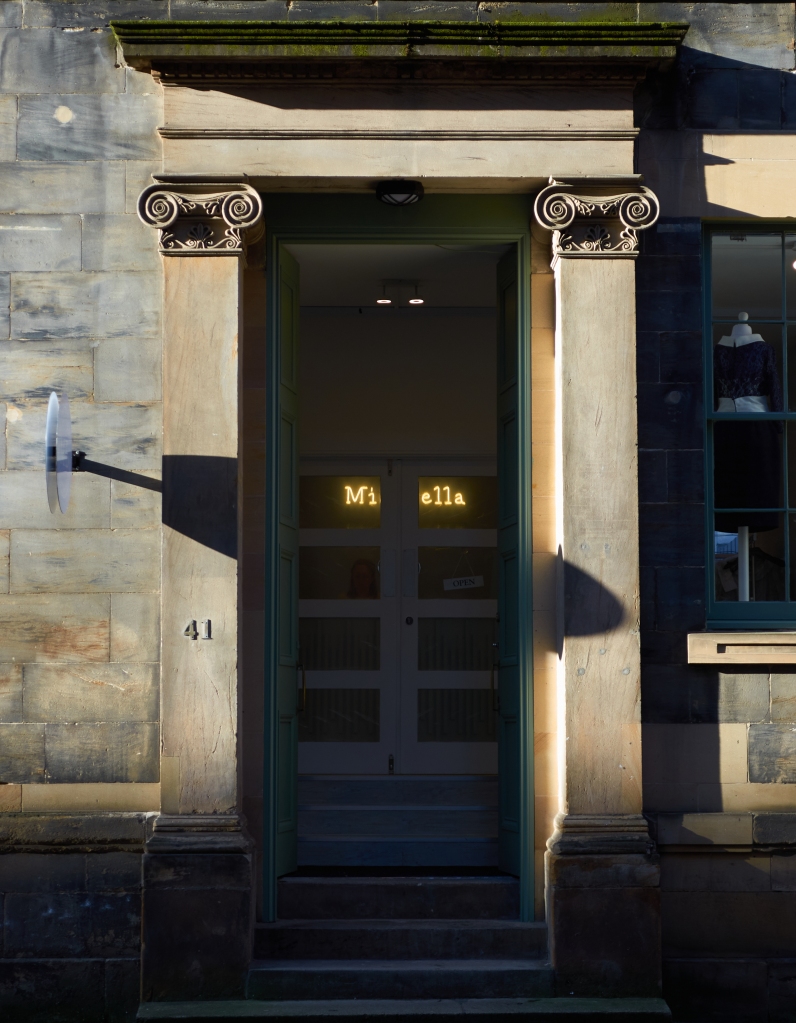
Entrance at no.41: Note the execution of the spiral coiled volutes. Compare these with 118 Blytheswood Square which is a known build by Robert Scott along with 172-188 West Regent Street. (184)
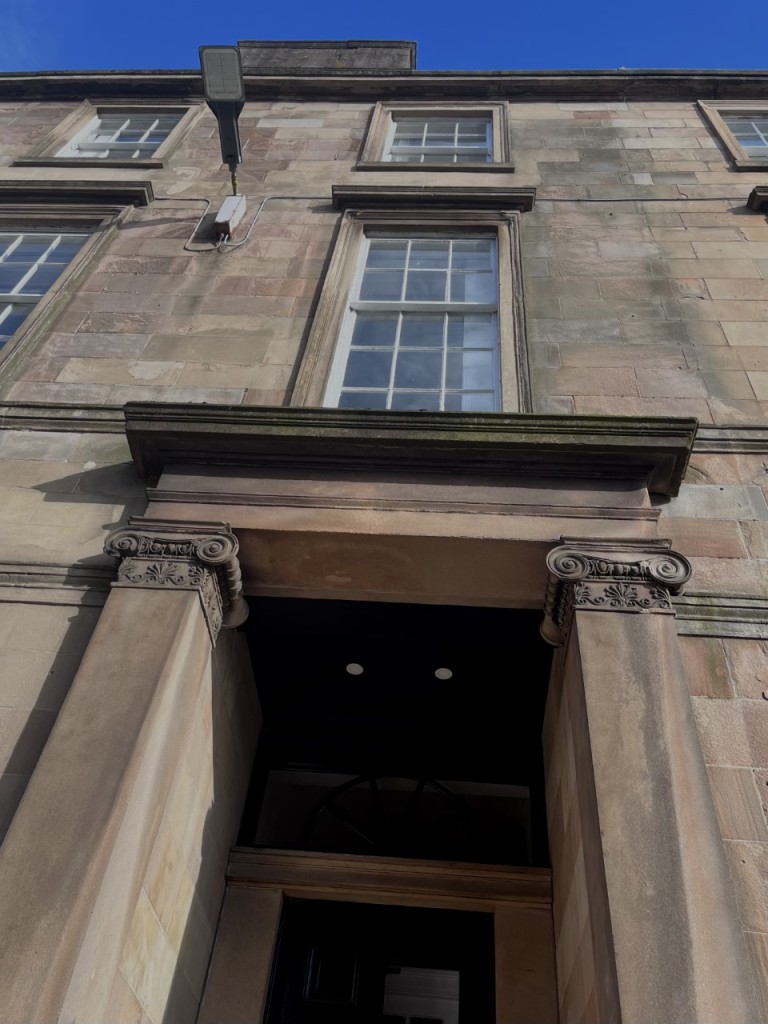
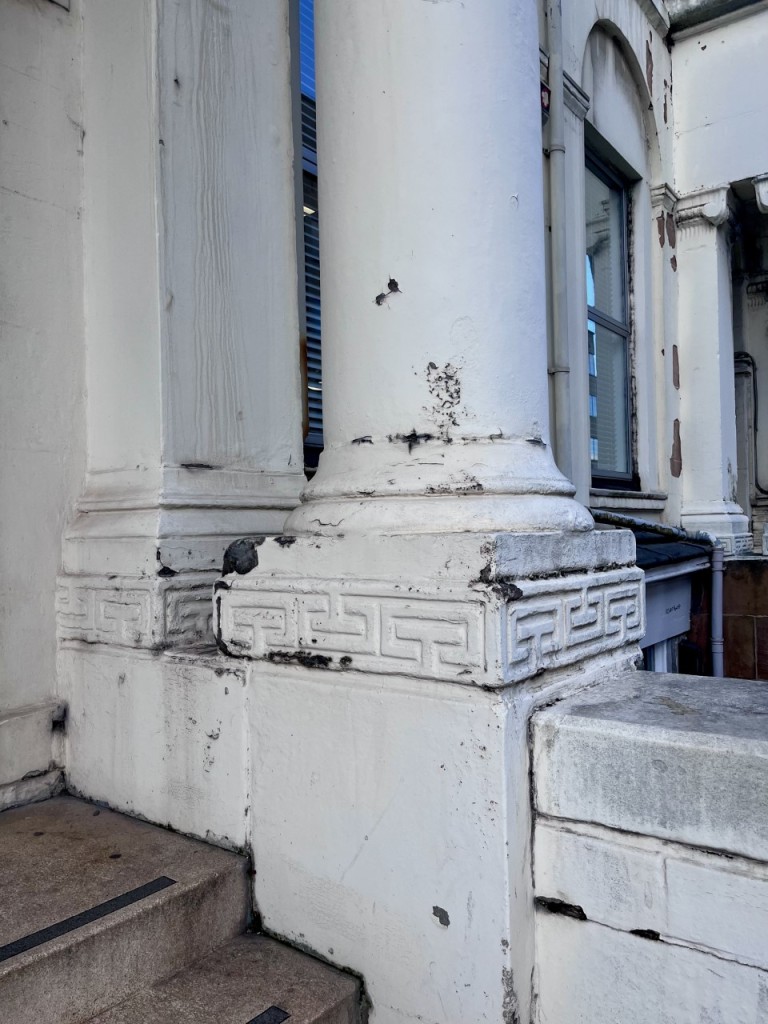
© Cicerone: MerchantCityGlasgow. All Rights Reserved. 2023
